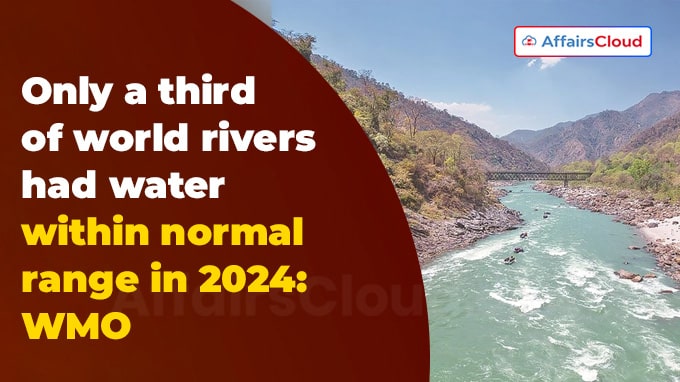 In September 2025, the World Meteorological Organisation (WMO) released its latest “State of the Global Water Resources Report 2024”. As per the report, only 1/3rd (approximately 33.3%) of the global river basins had ‘normal’ conditions in 2024.
In September 2025, the World Meteorological Organisation (WMO) released its latest “State of the Global Water Resources Report 2024”. As per the report, only 1/3rd (approximately 33.3%) of the global river basins had ‘normal’ conditions in 2024.
- The report further highlighted around 60% of the global rivers recorded either excessive or deficient water flows for the 6th consecutive year.
Exam Hints:
- Report Name: “State of the Global Water Resources Report 2024”
- Released by: WMO
- Global River Basins Normal Conditions: 1/3rd
- Abnormal water flows: 60% of global river basins
- Hottest Year: 2024
- Total Glacier Loss: 450 Gt (in 2024)
- Drought-hit Regions: North South America and the Amazon Basin and Southern Africa.
- Wetter Regions: Kazakhstan, and Southern Russia, Central Europe, Pakistan, Northern India, among others
About State of the Global Water Resources Report :
Purpose: The report, one of a suite of WMO reports, is published annually. It provides comprehensive assessment of global freshwater availability, including streamflow, reservoirs, lakes, groundwaters, among others.
Supporting Organisations: The report is supported by international organisations such as: National Aeronautics and Space Administration (NASA), European Space Agency (ESA), the German Research Centre for Geosciences (GFZ), the World Glacier Monitoring Service(WGMS), Global Runoff Data Center (GDRC) and the International Groundwater Resources Assessment Centre(IGRAC).
Key Findings of the Report:
Hottest Year: As per the report, the year 2024 was the hottest year in the 175-observational record, with global surface temperatures reaching 1.55 °C above pre-industrial levels.
Impact of El Nino: El Nino event had impacted major river basins worldwide like: it brought droughts in north South America and the Amazon Basin and Southern Africa.
- While, other regions like: Central and Western Africa, the Lake Victoria Basin (Africa), Kazakhstan, and Southern Russia, Central Europe, Pakistan, and Northern India, were wetter than normal.
Anomalies in Average River Discharge: The report revealed that in the last 6 years, only about 1/3rd (33.3%) of the river catchment area had normal discharge conditions compared to the 1991-2020 average.
- The report noted below-normal discharge across major river basins such as: the Amazon, Sao Francisco, Parana, and Orinoco (in South America) and the Zambezi, Limpopo, Okavango, Orange basins (in Southern Africa).
- In contrast to it, above normal river discharge occurred across: Central Europe, and parts of Asia, which led to large-scale deluges in major basins including the Danube, Ganges, Godavari, and Indus.
- While, extensive flooding was recorded in Western African basins in Senegal, Niger, Lake Chad, Volta.
Anomaly in Lakes Surface Temperature: Nearly all out of selected 75 main lakes worldwide recorded above or much above normal temperatures in July 2024, affected the water quality.
Glacier Loss: As per the report, year 2024 marked as the 3rd consecutive year with widespread glacier loss across all regions; with 450 Giga tons (Gt) lost i.e. equivalent to a massive block of ice measuring 7 kilometer (km) ×7km×7km, or enough to fill 180 million Olympic-sized swimming pools.
- The report highlighted that regions like: Scandinavia, Svalbard, and North Asia, registered mass glacier loss, while some regions like the Canadian Arctic and Greenland experienced more moderate losses.
- Also, nearer tropics, Colombian glaciers lost 5% part of their total glaciers in 2024.
Extreme Events: The report showed that tropical zone of Africa experienced unusually heavy rainfall in 2024 compared to historical norms, resulting in nearly 2,500 fatalities and 4 million people displaced.
- The Europe region saw its most extensive flooding since 2013, with nearly 33% of the river networks exceeding high flood limits.
Key Projection for 2050: The United Nations (UN) Water has projected that 3.6 billion people will face inadequate access to water at least a month per year (annually) and further expected to increase to over 5 billion by 2050.
About World Meteorological Organisation (WMO):
It is a specialized agency of the United Nations (UN) for meteorology (weather and climate), operational hydrology and related geophysical sciences.
- It was established in 1950 and became UN’s specialized agency in 1951.
Secretary General– Celeste Saulo
Members– 193 members (187 member states and 6 territories)
Headquarters- Geneva, Switzerland




